Mushrooms, Rics, etc - The Corallimorph Family
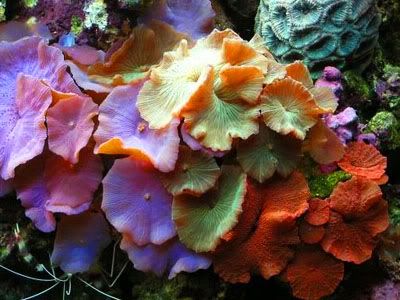

Family:
Corallimorph
Common Genus:
Amplexidiscus, Actinodiscus, Discosoma, Rhodactis, Ricordea, Corynactis
Common Names:
Mushroom Anemones, Mushroom
Corallimorphs or Mushroom Anemones are similar to sea anemones because they have no calcerous skeleton, but anatomically they more strongly resemble stony corals. Mushroom Corals also lack the long feeding tentacles of the both sea anemones and stony corals. These soft bodied animals have a flattened oral disc with a smooth, bumpy, or fuzzy appearance.
The beautiful coral anemones are very popular inhabitants for both the reef tank and the saltwater aquarium. Due to symbiotic zooxanthellae in their tissues, Mushroom Corals can have striking colors and patterning. They come in a wide range of colors including green, blue, purple, red, gray, or brown. They can be a solid color or have stripes radiating out from the center, and sometimes they can be spotted or mottled.
Corallimorphs are among the easiest corals to keep. These colorful aquarium inhabitants are enjoyed by both experienced and novice reef keepers. They make great beginner corals, so are often the first addition to a new reef aquarium. They are not only attractive, but they are hardy and durable.
The ability to tolerate changing environmental conditions makes Mushroom Corals well suited to captivity. They will reproduce quickly in well cared for systems, and are relatively inexpensive. When kept in a maintained environment with adequate lighting, their colors will brighten and turn your aquarium into an elegant showcase. They will reproduce quickly in well cared for systems, and are relatively inexpensive.

Mushroom Coral Care
Mushroom Anemones can be kept in most reef tank type set-ups or in hardy fish and invertebrate type marine aquariums. They can even be maintained in aquariums with just sand substrate, live rock, and an airstone for water movement and oxygenation. This is because they will tolerate high levels of organic compounds. But they will do even better, and their colors will brighten, in an aquarium with low levels of organic compounds.
Most prefer indirect light or shade so the VHO fluorescent or metal halide lighting is not required. Like most sea anemones, they use live rock or some other solid material to adhere to and they like low water movement.
Mushroom Coral Feeding
Corallimorphs that contain zooxanthellae, specimens from brightly lit shallow waters, need little feeding. Others will feed on dissolved and particulate matter and some feed on zooplankton. Larger specimens are known to trap and digest fish.
Some Mushroom Anemones have been known to go for months without dedicated feeding. But some corallimorphs will require regular feeding with chopped shrimp, mysis, worms, pulverized fish food, mussel, and fish roe; or plankton substitutes such as brine shrimp and Daphnia. It is important not to overfeed them.
Mushroom Coral Reproduction
The mushroom coral reproduces in many different ways (both asexually and sexually)- budding being one of the most frequently used processes. When a small coral breaks off from the reef to live along the sandy ocean floor, there is leftover tissue that remains on the original limestone pedestal. This tissue "buds" into a new mushroom coral. Mushroom coral also produce sexually through spawning- adult corals release eggs or sperm into the ocean which unite to develop a planula. The planula drifts along with the ocean currents until it settles on a different coral reef and begins to create a polyp, which is the basis of life for mushroom coral.
Current and Lighting
The overall rule of thumb for a thriving mushroom coral is a strong current, moderate level of light, and iodine supplementation. This is why mushroom coral care is so important.
Lighting is an important factor in mushroom coral care as the specimen will lose color and sometimes morph their shape into a cup form if they do not have steady access to light. In optimal conditions, the mushroom coral should be open completely and pressed flat against the surface it is attached to (usually a rock.) This is an important part of mushroom coral care.
Water Conditions
Any environmental change will most likely stress the mushroom coral (which can lead to disease and parasites), and water conditions are no exception. If conditions are not optimal to the coral's requirements, they will withdraw in on themselves, wrinkly dramatically, or even shrivel up. This is one of the most common mistakes among novice hobbyists. However, the mushroom coral should reopen within a week once the conditions level out. The quality of the tank's water should be frequently monitored, with maximum nitrates of 30-40ppm, a minimum pH of 7.8, a temperature range between 72-85F and a water density of 1.020, nitrates below 10ppm, phosphates below 0.04ppm, and silicates below 0.5ppm.
Types of Mushrooms
At present there are only about 56 known species of Mushroom Corals. Each Mushroom Coral species has its own unique appearance and behavior. Even though they are all very hardy, it's helpful and enjoyable to learn about each type of mushroom you plan to keep.
Some of the most popular, and commonly available, are species from these genera:
* Amplexidiscus
* Actinodiscus
* Discosoma
* Rhodactis
* Ricordea
* Corynactis
Amplexidiscus
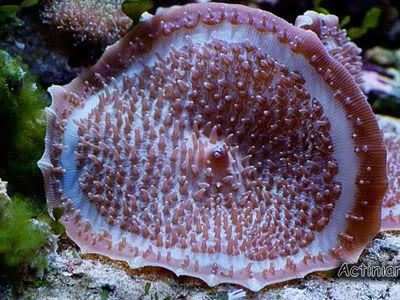
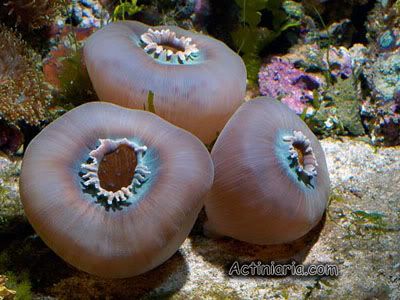
The mushroom corals known as the Elephant Ear Mushrooms are very curious animals. They are like the Venus Flytrap plant in animal form. Looking like an anemone, they attract small fish, especially small anemone fish but other fish as well, to take refuge in their oral disk. The disk doesn't sting them like most anemones would but it slowly closes on the fish until it cannot escape. Then the mouth opens and consumes the fish. It is suspected that the anemone secretes a drug which tranquilizes the fish and keeps it from trying to escape.
True Elephant Ear or Giant Cup Mushroom Amplexidiscus fenestraferElephant Ear Mushroom Anemone Amplexidiscus fenestrafer
In the Amplexidiscus genus, the True Elephant Ear or Giant Cup Mushroom Amplexidiscus fenestrafer is probably one of the most unusual corals available. They are the largest of the coral mushroom species.
It is usually cream colored or light grey, sometimes they have a greenish cast to them. The body can reach up to 18" (45 cm) in diameter but is usually 8 - 10 " (20 - 25 cm). There is a tenacle free area just inside the edge of the disc. Fluorescent light is preferred if it is indirect or for short periods. Low currents are preferred. The elephant ear can be fed shrimp or fish.
Discosoma and Actinodiscus

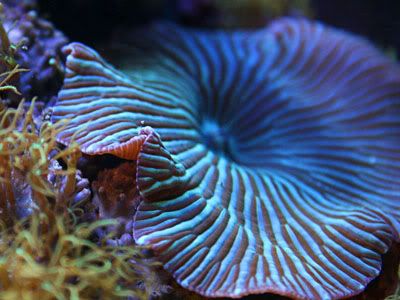
The most common mushroom anemones belong to the genus Discosoma. Generally they are disc shaped with a conical mouth, and the oral disc may be smooth, ribbed, with small or large pseudo tentacles or none at all. The edge of the oral disc may form pointed lappets or it may be uniformly circular as if cut by a cookie cutter. The consistency of the tissues is thick and, due to copious mucus production, they are slippery to the touch. They are the hardiest genus for aquarists, and most species thrive even under low light intensities. However, the metallic blue varieties keep their color best under strong illumination. Fluorescent orange and green varieties are spectacular to observe under blue light. Discosoma spp. tolerate strong water flow, but open largest under low velocity water currents. Strong lighting may cause them to curl the oral disc, and even bleach (lose pigment and zooxanthellae). I have been able to reverse this bleaching with the addition of a trace element supplement containing iron and manganese that I found promotes the health of zooxanthellae.
Rhodactis
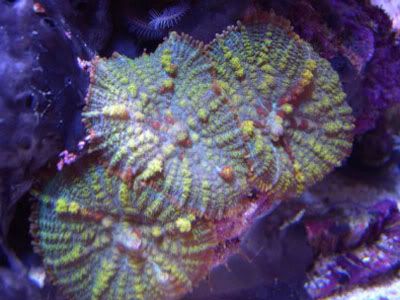
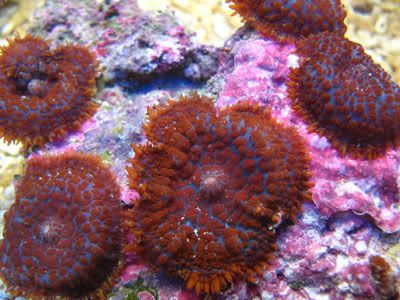
Have an oral disc covered with pseudotentacles that are usually branched. The edge of the oral disc in most species has toe-like tentacles, and there is often a naked tentacle-free margin separating the central oral disc from the edge of the disc. Some species have thick tissues, but many have rather thin tissues, much thinner than in typical Discosoma. Most are also slippery to the touch. Rhodactis spp., except R. cf. mussoides actively feed on fleshy food when it is offered, folding up the disc margins to envelop the food. The tentacled varieties of Rhodactis spp. tolerate and prefer much stronger light and water motion than most Discosoma spp. Large species of Rhodactis can trap fishes, in the same manner as the related genus Amplexidiscus. Rhodactis spp. reproduce by fission, pedal laceration, and a type of budding that involves the formation of gemmules both internally and on the surface of the oral disc.
Ricordea

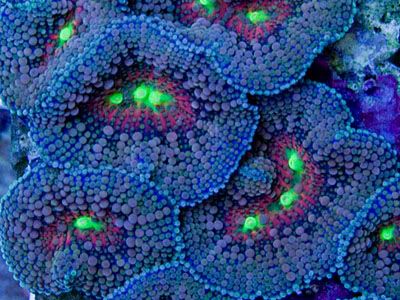
Have vesicle-like tentacles on the oral disc. While some species of Discosoma and Rhodactis may develop vesicles on the oral disc, there is no mistaking them with the pronounced tentacles of Ricordea. One look-alike that can be confused with Ricordea is Stichodactyla tapetum. The latter has sticky tentacles while the former does not. Both can form colonies of numerous individual polyps approximately 5 cm in diameter. Both reproduce by fission. Stichodactlya tapetum also has a form that may grow to 30 cm in diameter. The maximum size for Ricordea is about 15 cm in diameter. There are two widely recognized species of Ricordea, R. florida from the Atlantic and Caribbean, and R. yuma from the Indo-Pacific region. Both are very popular in the aquarium trade. Ricordea yuma is readily distinguished from R. florida by the fact that the former has pseudotentacles on the oral cone, while the latter does not. Also, R. florida often has numerous mouths and elongated irregular polyps, while R. yuma is usually circular, with one mouth. All are spectacular due to the grape-like tentacles on their oral disc, but some especially prized specimens have brilliant fluorescent proteins in shades of orange, red, pink, blue, and green.
Corynactis
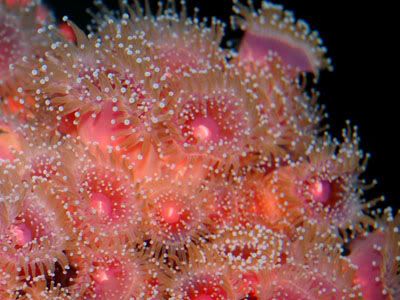

Corynactis spp. are mainly temperate species, known as Strawberry anemones. They are small, not usually larger than one inch (2.5 cm) in diameter, and colonial, reproducing by fission and pedal laceration to cover large areas of rocks. Tropical species may occasionally be introduced to aquariums with live rock. The tropical species are less colorful, tend to be cryptic, and form much less densely packed colonies. All Corynactis spp. feed on zooplankton and particulate organic matter. To keep them healthy and encourage division, they need to be fed at least several times per week. A "milkshake" of chopped seafood can be used, but they will also take flake or pelletized foods, and frozen shrimp or worms.
For more information see links below:
http://www.thesea.org/mushroom_coral/mushroom_coral_care.htm
http://animal-world.com/encyclo/reef/corallimorph/corallimorph.htm


Family:
Corallimorph
Common Genus:
Amplexidiscus, Actinodiscus, Discosoma, Rhodactis, Ricordea, Corynactis
Common Names:
Mushroom Anemones, Mushroom
Corallimorphs or Mushroom Anemones are similar to sea anemones because they have no calcerous skeleton, but anatomically they more strongly resemble stony corals. Mushroom Corals also lack the long feeding tentacles of the both sea anemones and stony corals. These soft bodied animals have a flattened oral disc with a smooth, bumpy, or fuzzy appearance.
The beautiful coral anemones are very popular inhabitants for both the reef tank and the saltwater aquarium. Due to symbiotic zooxanthellae in their tissues, Mushroom Corals can have striking colors and patterning. They come in a wide range of colors including green, blue, purple, red, gray, or brown. They can be a solid color or have stripes radiating out from the center, and sometimes they can be spotted or mottled.
Corallimorphs are among the easiest corals to keep. These colorful aquarium inhabitants are enjoyed by both experienced and novice reef keepers. They make great beginner corals, so are often the first addition to a new reef aquarium. They are not only attractive, but they are hardy and durable.
The ability to tolerate changing environmental conditions makes Mushroom Corals well suited to captivity. They will reproduce quickly in well cared for systems, and are relatively inexpensive. When kept in a maintained environment with adequate lighting, their colors will brighten and turn your aquarium into an elegant showcase. They will reproduce quickly in well cared for systems, and are relatively inexpensive.

Mushroom Coral Care
Mushroom Anemones can be kept in most reef tank type set-ups or in hardy fish and invertebrate type marine aquariums. They can even be maintained in aquariums with just sand substrate, live rock, and an airstone for water movement and oxygenation. This is because they will tolerate high levels of organic compounds. But they will do even better, and their colors will brighten, in an aquarium with low levels of organic compounds.
Most prefer indirect light or shade so the VHO fluorescent or metal halide lighting is not required. Like most sea anemones, they use live rock or some other solid material to adhere to and they like low water movement.
Mushroom Coral Feeding
Corallimorphs that contain zooxanthellae, specimens from brightly lit shallow waters, need little feeding. Others will feed on dissolved and particulate matter and some feed on zooplankton. Larger specimens are known to trap and digest fish.
Some Mushroom Anemones have been known to go for months without dedicated feeding. But some corallimorphs will require regular feeding with chopped shrimp, mysis, worms, pulverized fish food, mussel, and fish roe; or plankton substitutes such as brine shrimp and Daphnia. It is important not to overfeed them.
Mushroom Coral Reproduction
The mushroom coral reproduces in many different ways (both asexually and sexually)- budding being one of the most frequently used processes. When a small coral breaks off from the reef to live along the sandy ocean floor, there is leftover tissue that remains on the original limestone pedestal. This tissue "buds" into a new mushroom coral. Mushroom coral also produce sexually through spawning- adult corals release eggs or sperm into the ocean which unite to develop a planula. The planula drifts along with the ocean currents until it settles on a different coral reef and begins to create a polyp, which is the basis of life for mushroom coral.
Current and Lighting
The overall rule of thumb for a thriving mushroom coral is a strong current, moderate level of light, and iodine supplementation. This is why mushroom coral care is so important.
Lighting is an important factor in mushroom coral care as the specimen will lose color and sometimes morph their shape into a cup form if they do not have steady access to light. In optimal conditions, the mushroom coral should be open completely and pressed flat against the surface it is attached to (usually a rock.) This is an important part of mushroom coral care.
Water Conditions
Any environmental change will most likely stress the mushroom coral (which can lead to disease and parasites), and water conditions are no exception. If conditions are not optimal to the coral's requirements, they will withdraw in on themselves, wrinkly dramatically, or even shrivel up. This is one of the most common mistakes among novice hobbyists. However, the mushroom coral should reopen within a week once the conditions level out. The quality of the tank's water should be frequently monitored, with maximum nitrates of 30-40ppm, a minimum pH of 7.8, a temperature range between 72-85F and a water density of 1.020, nitrates below 10ppm, phosphates below 0.04ppm, and silicates below 0.5ppm.
Types of Mushrooms
At present there are only about 56 known species of Mushroom Corals. Each Mushroom Coral species has its own unique appearance and behavior. Even though they are all very hardy, it's helpful and enjoyable to learn about each type of mushroom you plan to keep.
Some of the most popular, and commonly available, are species from these genera:
* Amplexidiscus
* Actinodiscus
* Discosoma
* Rhodactis
* Ricordea
* Corynactis
Amplexidiscus


The mushroom corals known as the Elephant Ear Mushrooms are very curious animals. They are like the Venus Flytrap plant in animal form. Looking like an anemone, they attract small fish, especially small anemone fish but other fish as well, to take refuge in their oral disk. The disk doesn't sting them like most anemones would but it slowly closes on the fish until it cannot escape. Then the mouth opens and consumes the fish. It is suspected that the anemone secretes a drug which tranquilizes the fish and keeps it from trying to escape.
True Elephant Ear or Giant Cup Mushroom Amplexidiscus fenestraferElephant Ear Mushroom Anemone Amplexidiscus fenestrafer
In the Amplexidiscus genus, the True Elephant Ear or Giant Cup Mushroom Amplexidiscus fenestrafer is probably one of the most unusual corals available. They are the largest of the coral mushroom species.
It is usually cream colored or light grey, sometimes they have a greenish cast to them. The body can reach up to 18" (45 cm) in diameter but is usually 8 - 10 " (20 - 25 cm). There is a tenacle free area just inside the edge of the disc. Fluorescent light is preferred if it is indirect or for short periods. Low currents are preferred. The elephant ear can be fed shrimp or fish.
Discosoma and Actinodiscus


The most common mushroom anemones belong to the genus Discosoma. Generally they are disc shaped with a conical mouth, and the oral disc may be smooth, ribbed, with small or large pseudo tentacles or none at all. The edge of the oral disc may form pointed lappets or it may be uniformly circular as if cut by a cookie cutter. The consistency of the tissues is thick and, due to copious mucus production, they are slippery to the touch. They are the hardiest genus for aquarists, and most species thrive even under low light intensities. However, the metallic blue varieties keep their color best under strong illumination. Fluorescent orange and green varieties are spectacular to observe under blue light. Discosoma spp. tolerate strong water flow, but open largest under low velocity water currents. Strong lighting may cause them to curl the oral disc, and even bleach (lose pigment and zooxanthellae). I have been able to reverse this bleaching with the addition of a trace element supplement containing iron and manganese that I found promotes the health of zooxanthellae.
Rhodactis


Have an oral disc covered with pseudotentacles that are usually branched. The edge of the oral disc in most species has toe-like tentacles, and there is often a naked tentacle-free margin separating the central oral disc from the edge of the disc. Some species have thick tissues, but many have rather thin tissues, much thinner than in typical Discosoma. Most are also slippery to the touch. Rhodactis spp., except R. cf. mussoides actively feed on fleshy food when it is offered, folding up the disc margins to envelop the food. The tentacled varieties of Rhodactis spp. tolerate and prefer much stronger light and water motion than most Discosoma spp. Large species of Rhodactis can trap fishes, in the same manner as the related genus Amplexidiscus. Rhodactis spp. reproduce by fission, pedal laceration, and a type of budding that involves the formation of gemmules both internally and on the surface of the oral disc.
Ricordea


Have vesicle-like tentacles on the oral disc. While some species of Discosoma and Rhodactis may develop vesicles on the oral disc, there is no mistaking them with the pronounced tentacles of Ricordea. One look-alike that can be confused with Ricordea is Stichodactyla tapetum. The latter has sticky tentacles while the former does not. Both can form colonies of numerous individual polyps approximately 5 cm in diameter. Both reproduce by fission. Stichodactlya tapetum also has a form that may grow to 30 cm in diameter. The maximum size for Ricordea is about 15 cm in diameter. There are two widely recognized species of Ricordea, R. florida from the Atlantic and Caribbean, and R. yuma from the Indo-Pacific region. Both are very popular in the aquarium trade. Ricordea yuma is readily distinguished from R. florida by the fact that the former has pseudotentacles on the oral cone, while the latter does not. Also, R. florida often has numerous mouths and elongated irregular polyps, while R. yuma is usually circular, with one mouth. All are spectacular due to the grape-like tentacles on their oral disc, but some especially prized specimens have brilliant fluorescent proteins in shades of orange, red, pink, blue, and green.
Corynactis


Corynactis spp. are mainly temperate species, known as Strawberry anemones. They are small, not usually larger than one inch (2.5 cm) in diameter, and colonial, reproducing by fission and pedal laceration to cover large areas of rocks. Tropical species may occasionally be introduced to aquariums with live rock. The tropical species are less colorful, tend to be cryptic, and form much less densely packed colonies. All Corynactis spp. feed on zooplankton and particulate organic matter. To keep them healthy and encourage division, they need to be fed at least several times per week. A "milkshake" of chopped seafood can be used, but they will also take flake or pelletized foods, and frozen shrimp or worms.
For more information see links below:
http://www.thesea.org/mushroom_coral/mushroom_coral_care.htm
http://animal-world.com/encyclo/reef/corallimorph/corallimorph.htm